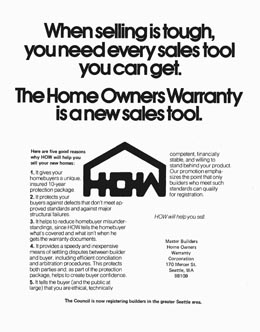On February 6, 1975, the Seattle Master Builders Association kicks off its Home Owners Warranty program (HOW) with a celebratory dinner at Seattle's Moose Club. By the time the plates have been cleared, 30 local builders will sign pledges to join in. Under the program, builders will pay a registration fee of $150 and an additional $2 for each $1,000 of a home's final sales price. In return, builders are able to identify themselves with the warranty program, protect their customers, and avoid open-ended liability for defective work or materials.
Good for Builders, Good for Buyers
The featured speaker at the event was Candi Gordon, the assistant field services director for the National Home Owner Warranty Council, based in Washington, D.C. During her speech, Gordon told her audience, "This the highest rate of participation of any builder group in the nation. I am really impressed by the enthusiasm of your members and by the pride they take in their work" (Master Builder, February 1975, p. 16). She added:
"Pretty soon, you won't be able to sell a house without a warranty, and we suspect the day isn't far off that a builder won't be able to get financing unless he's a registered HOW member. This is what happened in England, where they have had a program since the early 1960s" (Master Builder, February 1975).
Pete Hansell, a local builder and chairman of the Seattle Home Owners Warranty Council, provided the audience with some background on the need for such a program:
"A recent poll showed the homebuilder ranks just above the used-car salesman in terms of consumer confidence. HOW is designed to change that image, to make the builder a good guy — and to do it without government interference in our business" (Master Builder, February 1975).
Under the 10-year-warranty plan, for the first year after a sale the builder alone is responsible for correcting any faulty workmanship or defective materials. For an additional year, the builder warrants the proper installation and operation of all plumbing, heating, cooling, and electrical systems. Major construction defects are covered for 10 years after sale, but a builder's liability only lasts for the initial two years; after that, a national insurer is responsible for paying to correct such defects. The same insurer also protects homeowners in the event that a builder is unable to perform his or her obligations during the initial two-year warranty period.
Seattle builder Larry Hillis summed up the benefits the program would provide to its participants:
"I could probably have a house fall down and build it again from scratch for the amount I'll put out each year in insurance premiums, but it's worth every penny, because it'll help my relations with the buyers of my homes. Besides, after two years, I've got an insurance company to back me up and I'm free. That's an investment" (Master Builder, February 1975).
Within just two years, the warranty program was to prove its worth to builders in another way. In 1977 the Veterans Administration announced that, for homes insured under the warranty program, it would waive its inspection requirement for VA financing. This not only saved builders the cost of the inspection, but also allowed them to avoid the sometimes-lengthy delays caused by the inspection and approval requirement.

